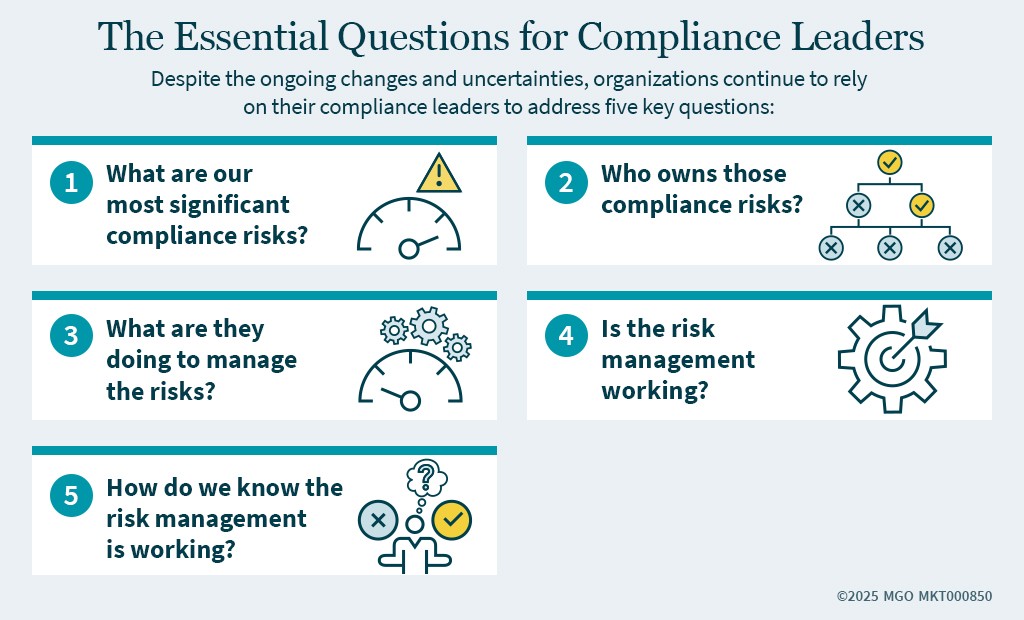Key Takeaways
- In times of uncertainty, strong compliance practices provide structure, mitigate risk, and improve your decision-making efficiency.
- Executives should reinforce ethical behavior through clear communication, proactive risk assessment, and non-retaliatory reporting mechanisms.
- While regulatory enforcement fluctuates, maintaining compliance safeguards your business against legal risks and enhances operational effectiveness.
—
In today’s ever-changing business environment, uncertainty and lack of predictability have become constants, posing significant challenges for organizations worldwide. For Chief Compliance Officers, this unpredictability translates into increased inefficiency and discomfort, as the future remains uncertain. Against this backdrop, some companies might be tempted to reduce their focus on and investment in compliance and business integrity, viewing it as an opportunity to cut costs. However, operating in compliance and with business integrity is crucial, especially during times of adversity like these.
The Essential Questions for Compliance Leaders
Despite the ongoing changes and uncertainties, organizations continue to rely on their compliance leaders to address five key questions:
- What are our most significant compliance risks?
- Who owns them?
- What are they doing to manage the risks?
- Is it working?
- How do we know?
Compliance and business integrity can serve as stabilizing forces for companies and employees during uncertain times. They reinforce clear expectations for employees to act ethically, raise questions, and report concerns. Moreover, they enable companies to evaluate and adjust their risk appetite, leading to fewer mistakes and better, more efficient business decision-making.
Strategies for Companies Facing Compliance Challenges
In times of adversity, whether facing a change in the regulatory environment or dealing with an economic downturn, the tone at the top is especially important. Communications from executives and compliance leaders should emphasize that, despite external challenges, the organization’s commitment to compliance and business integrity remains unwavering. These messages can be integrated into existing communication channels, such as town halls, staff meetings, and compliance newsletters.
Employees are paying attention to leadership’s actions and words. It’s crucial to reinforce your organization’s internal mechanisms for raising compliance questions and reporting concerns. When questions and concerns are raised, make sure they are addressed as part of the overall investigations process, demonstrating seriousness, confidentiality, and appropriate action when allegations of non-compliance are substantiated. Partnering with Human Resources to prevent retaliation for raising compliance concerns in good faith is also vital.
However uncomfortable it may be, adversity always presents opportunities. The key is to seek it out and to find it. Consider leveraging your compliance risk assessment process or other risk assessment processes (e.g., ERM, internal audit) to uncover opportunities and to identify new or emerging risks, allocate resources efficiently, evaluate control effectiveness, and reassess the organization’s risk appetite.
Preparing for the Future
Regulatory enforcement varies with changes in the law and leadership. If an organization is in a lenient regulatory environment today, the pendulum will eventually swing back to a more strict one. Companies engaging in misconduct may not face immediate consequences, but statutes of limitations are long, and whistleblower protections are robust. In the meantime, compliance leaders may be challenged to justify the allocation of resources to the compliance function and program. Compliance leaders must be prepared to demonstrate the return on investment – that is, both the avoidance of fines, penalties and other negative consequences that can result from non-compliance, and the role compliance plays in helping the business run better and more efficiently. Your existing reporting channels – to management, to the Audit Committee and to employees – provide opportunities to demonstrate that return on investment, justify resource allocation, ensuring reporting is concise, relevant, and demonstrates compliance’s value. Sharing stories where compliance involvement led to better business decisions, such as new product development, geographic expansion, or acquisitions, can be compelling.
Reevaluating metrics and measures of effectiveness, sharpening the message they convey, and leveraging data analytics can further enhance the ability to demonstrate the internal rate of return on compliance investments.

How MGO Can Help
At MGO, we understand the immense pressure compliance leaders face in navigating today’s dynamic regulatory landscape. Our team of professionals partners with organizations to build, evaluate, and strengthen your compliance programs so they not only meet regulatory requirements but also add measurable business value. We help you identify and manage key risks, assess the effectiveness of your controls and establish meaningful metrics that resonate with executive leadership. Contact us to learn how we can help your business turn compliance into a source of resilience, efficiency, and competitive advantage.
Written by Jack Holleran. Copyright © 2025 BDO USA, P.C. All rights reserved. www.bdo.com